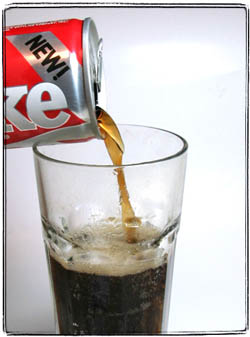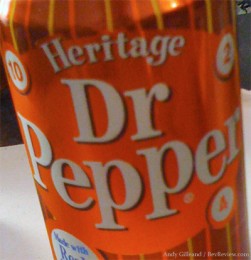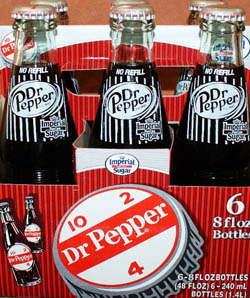In his solo hit “Heart of the Matter,” Don Henley famously sang that “if you keep carryin’ that anger, it’ll eat you up inside.” While I’m all for forgiveness where deserved, I’m also all about holding a grudge when necessary. Do you remember the first time that you were lied to as a consumer? You’d better believe that I do, and I can sum it all up in two words: New Coke. Product variations and revisions are risky, and I’ve been hurt a few times over the years.
Today, we’re going to talk about the new limited edition offering of Heritage Dr. Pepper, but before we get there, I feel like I should give you a personal rundown of how I became a Dr. Pepper fan. To do this, we’re going to chart my soda drinking history, brand-by-brand.
Before I became a Pepper, I was originally a Coke guy, or Mr. Pibb if I could get it. I loved going to work with my dad, because they had a pop machine at the office that served up nice cold bottles of my favorite beverages, and I could always get my dad to lend me a few coins to pick one up. For me, there was nothing better than an icy cold bottle of Coca-Cola, one of the true pleasures in life that was just as good as the commercials that you saw on television. Unlike the fast food sandwiches that you saw on television that looked completely different in person (read: gross), the experience of drinking a Coke was as advertised, completely awesome. Coke was it.
 1985 came around, and Coca-Cola had the brilliant (insert sarcasm here) idea to change the formula of their classic soft drink, setting off one of the largest marketing disasters of all time with the introduction of “New Coke.” Reaction was quick, and it was negative, and worst of all, I could no longer get my favorite drink. It was New Coke, or no Coke at all for the 11 year old me. So I chose “no Coke” as my option, and moved to drinking Mr. Pibb exclusively. Eventually, Coca-Cola tried to save face with the introduction of Coca-Cola Classic, but even that tasted somehow different from the original Coke that I had once known and loved.
1985 came around, and Coca-Cola had the brilliant (insert sarcasm here) idea to change the formula of their classic soft drink, setting off one of the largest marketing disasters of all time with the introduction of “New Coke.” Reaction was quick, and it was negative, and worst of all, I could no longer get my favorite drink. It was New Coke, or no Coke at all for the 11 year old me. So I chose “no Coke” as my option, and moved to drinking Mr. Pibb exclusively. Eventually, Coca-Cola tried to save face with the introduction of Coca-Cola Classic, but even that tasted somehow different from the original Coke that I had once known and loved.
When we moved to Ohio, Mr. Pibb was not widely available at local grocery stores, and it was at that point that I officially met Dr. Pepper, my beloved drink which many have come to associate as a signature part of my personality.
While I’ve consistently been a Dr. Pepper drinker since the late ’80s, I am always interested in soda developments as they come and go, although I never quite got up the nerve to try Jolt Cola – their marketing ploy of “all of the sugar and twice the caffeine” made my head hurt, just thinking about it.
Some other beverage thoughts:
Diet beverages, i.e. Diet Coke, Diet Dr. Pepper, Coke Zero – “taste just as good as the original.” Um, not quite. Further, Coke Zero is complete flavorless crap. It really is truth in advertising – Coke Zero= taste that is zero, and enjoyment that rates at zero. Yuck.
Soda Myth: When ordering a beverage in a restaurant that does not serve Pepsi products, root beer is an acceptable substitute for Dr. Pepper.
Truth: Not even close. Waiters and waitresses, please take note and stop lying to us.
Speaking of root beer though, Mug Root Beer allegedly sent the foam straight to the end user’s brain – and while I can not specifically comment on that, Mug Root Beer was delicious, and I miss it. Although it’s apparently still in production, I can’t find it in Ohio. Boo.
Cherry-vanilla Dr. Pepper – while this seems like a good idea on paper, ultimately it tasted like a flat Dr. Pepper that had been left out on the kitchen counter overnight. I hear that the newer Cherry Dr. Pepper is better, with a more pronounced cherry taste – something that I’ll look forward to trying. I refused to try the “Berries and Cream” version of Dr. Pepper that was briefly available in 2006/2007 – that just sounded gross to me.
 Which brings us to Heritage Dr. Pepper, a product that began appearing in stores this past November. Made with real sugar, instead of the high fructose corn syrup that the company has been using since the ’70s, Dr. Pepper fans can finally drink (albeit, for a limited time only) a version of Dr. Pepper that is likely as close to the “original stuff” as you’ll ever taste, unless you’re willing to import the original formula from Dublin, TX (or unless you live in the UK, where they apparently also get the full sugar experience).
Which brings us to Heritage Dr. Pepper, a product that began appearing in stores this past November. Made with real sugar, instead of the high fructose corn syrup that the company has been using since the ’70s, Dr. Pepper fans can finally drink (albeit, for a limited time only) a version of Dr. Pepper that is likely as close to the “original stuff” as you’ll ever taste, unless you’re willing to import the original formula from Dublin, TX (or unless you live in the UK, where they apparently also get the full sugar experience).
I was interested to sample Heritage Dr. Pepper for myself, and finally got the chance when I tracked down my own twelve pack of the hallowed beverage at Christmastime. After icing it down in the refrigerator for several hours, I opened my first Heritage Dr. Pepper and took a sip. The taste was definitely different, although not necessarily in a positive way. I found that the use of “real sugar” actually took away some of the traditional flavor, rather than the enhanced flavor that I was expecting/hoping for. In fact, the expected taste that I was hoping for was far enough removed from what I’m normally used to, to the point that it almost had a bit of a diet taste to it, lighter than the current formula. Old school (read: older than me) Dr. Pepper drinkers have said that the sugar taste is an adjustment for anyone used to normally drinking beverages fueled by the high fructose corn syrup.
Whatever the case might be, I’ll stick to the more familiar blend of Dr. Pepper that I know and love. The authentic blend of 23 flavors might not be quite what the doctor ordered for some soda fans, but for me, it’s just right. I’m inclined to believe that whether it is made with sugar or high fructose corn syrup, you’re really splitting hairs to say that there is a significant difference in the taste. Sorry guys, I’m just not that much of a beverage snob. I will definitely argue that the taste of any brand of soda will always be superior when it comes from a glass bottle. The soda drinking experience lost a lot when they moved to packaging them in plastic bottles and cans – it just doesn’t taste the same.
However, my curiosity has been piqued, and I will add Dublin Dr. Pepper to the list of things that I will plan to try in 2010, along with Mexican Coke, which I’m also very curious about. There are at least subtle differences between Heritage Dr. Pepper and Dublin Dr. Pepper – HDP uses a cane and beet sugar mix, while DDP uses pure cane sugar. The difference? We’ll have to wait and see on that one.

Who knew that drinking a simple soft drink could be so complicated? I did learn a few things along the way, including the significance of the numeric sequence of 10-2-4 that once could be found on containers of Dr. Pepper. In the ’20s, Dr. Walter Eddy discovered in his studies at Columbia University that all of us experience a natural drop in energy at 10:30am, 2:30pm, and 4:30pm. He also discovered that people are able to avoid that energy drop with a quick snack or drink at 10, 2, and 4. And hence, Dr. Pepper had a marketing strategy on their hands that famously targeted the beverage as the 10-2-4 solution to avoid the energy drop. And with this bit of gained knowledge, I’ve finally learned something that I’ve been trying to convince many of for years – Dr. Pepper really is good for you!
I’m kidding. Kind of.




Comments